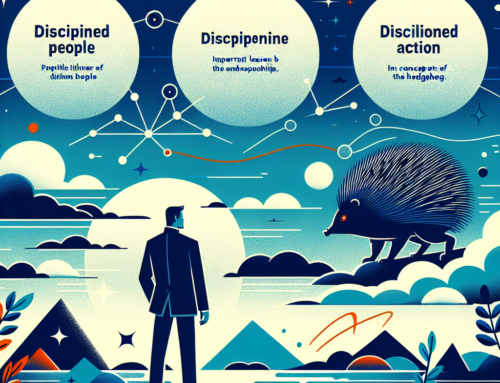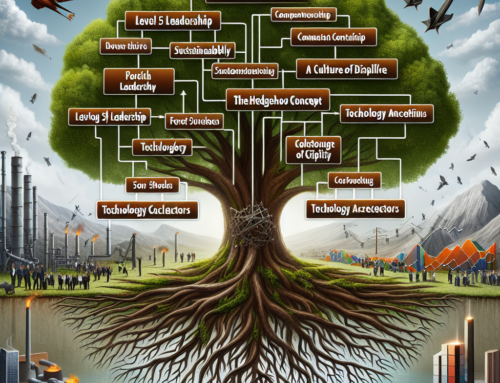
The Hedgehog Concept: How Focusing on What You Do Best Can Lead to Greatness
Jim Collins, a renowned business consultant and author, is best known for his book ”Good to Great,” which explores the factors that differentiate successful companies from their mediocre counterparts. In this book, Collins introduces the concept of the Hedgehog Concept, which he believes is crucial for businesses to achieve greatness.
The Hedgehog Concept is based on an ancient Greek parable that talks about a fox and a hedgehog. The fox is cunning and has many strategies to catch the hedgehog, but the hedgehog has one simple defense mechanism – it rolls into a ball, and its spines protect it. The fox, despite all its efforts, cannot defeat the hedgehog. This parable is used as a metaphor for businesses, where the fox represents complexity and the hedgehog represents simplicity.
According to Collins, the Hedgehog Concept is about finding the intersection of three circles – what you are deeply passionate about, what you can be the best in the world at, and what drives your economic engine. Let’s delve deeper into each of these circles and understand how they can lead to business greatness.
The first circle is about finding what you are deeply passionate about. This is not just about what you like or enjoy doing; it’s about what truly drives you and gives you a sense of purpose. Collins emphasizes that businesses should focus on what they are passionate about, rather than chasing trends or trying to imitate their competitors. When a company is passionate about what they do, it becomes a driving force that keeps them going, even during tough times.
The second circle is about finding what you can be the best in the world at. This is not just about being good at something; it’s about being the best. Collins argues that businesses should focus on their strengths and what they do best, rather than trying to be everything to everyone. By focusing on their strengths, businesses can differentiate themselves from their competitors and become the best in their industry.
The third and final circle is about finding what drives your economic engine. This is about understanding how your business makes money and what factors contribute to its success. Collins believes that businesses should focus on their core competencies and find ways to monetize them. This could mean diversifying into related products or services or finding new markets to tap into. By understanding their economic engine, businesses can ensure long-term sustainability and growth.
The key to the Hedgehog Concept is finding the intersection of these three circles. When a business aligns its passion, strengths, and economic engine, it creates a powerful force that can lead to greatness. However, this is easier said than done. Many businesses struggle to find this intersection, and some may never find it. But for those who do, the results can be truly remarkable.
One example of a company that has successfully implemented the Hedgehog Concept is Southwest Airlines. The company’s passion is to provide affordable and convenient air travel, its strength lies in its low-cost operations and excellent customer service, and its economic engine is its high load factor and low operating costs. By focusing on these three circles, Southwest Airlines has become one of the most successful and profitable airlines in the world.
In conclusion, the Hedgehog Concept is a powerful tool for businesses to achieve greatness. By focusing on what they are passionate about, what they can be the best in the world at, and what drives their economic engine, businesses can differentiate themselves from their competitors and create a sustainable path to success. As Jim Collins says, ”The fox knows many things, but the hedgehog knows one big thing.” And for businesses, that one big thing is the Hedgehog Concept.
Level 5 Leadership: Why Humility and Willpower are Key Traits for Business Success
When it comes to achieving success in business, there are many factors that come into play. From having a solid business plan to implementing effective strategies, there are countless elements that contribute to a company’s growth and success. However, according to renowned business author Jim Collins, there are two key traits that stand out above the rest when it comes to taking a company from good to great: humility and willpower.
Collins’ book ”Good to Great” has become a staple in the business world, with its in-depth analysis of companies that have achieved long-term success and sustained growth. Through his research, Collins identified a common thread among these companies – they all had what he calls ”Level 5 Leaders.”
So, what exactly is a Level 5 Leader? According to Collins, these are leaders who possess a unique combination of humility and willpower. They are not only driven and determined, but they also have the ability to put their ego aside and focus on the success of the company as a whole.
Humility is often seen as a weakness in the business world, where confidence and assertiveness are highly valued. However, Collins argues that humility is actually a strength when it comes to leadership. Humble leaders are able to acknowledge their own limitations and mistakes, and are open to learning from others. They are not afraid to surround themselves with talented individuals and give credit where credit is due.
On the other hand, willpower is a trait that is often associated with successful leaders. It is the ability to persevere through challenges and setbacks, and to stay focused on long-term goals. Willpower is what drives leaders to push through difficult times and make tough decisions for the betterment of the company.
But what sets Level 5 Leaders apart is their ability to balance humility and willpower. They are not only driven and determined, but they also have the humility to recognize that they cannot achieve success on their own. They understand the importance of building a strong team and empowering others to contribute to the company’s growth.
One example of a Level 5 Leader is Alan Mulally, the former CEO of Ford Motor Company. When Mulally took over as CEO in 2006, Ford was struggling and on the brink of bankruptcy. However, through his leadership, Mulally was able to turn the company around and make it profitable again. He did this by setting aside his ego and working collaboratively with his team, listening to their ideas and empowering them to make decisions. This approach not only led to financial success for Ford, but also a positive and inclusive company culture.
So, how can aspiring leaders develop these traits of humility and willpower? Collins suggests that it starts with self-awareness and a willingness to learn and grow. Leaders should be open to feedback and be willing to admit when they are wrong. They should also focus on building a strong team and creating a culture of trust and collaboration.
In addition, leaders should have a clear vision and purpose for their company, and be willing to make tough decisions that align with this vision. This requires a strong sense of willpower and determination, but also the humility to recognize when changes need to be made.
In conclusion, Jim Collins’ concept of Level 5 Leadership highlights the importance of humility and willpower in achieving long-term success in business. These traits may seem contradictory, but when balanced correctly, they can lead to a powerful and effective leadership style. Aspiring leaders should strive to develop these traits and create a culture of humility and willpower within their organizations. By doing so, they can take their companies from good to great and achieve sustainable growth and success.
The Flywheel Effect: How Small Wins Can Lead to Big Results in Business Growth
When it comes to achieving success in business, there are many theories and strategies out there. However, one concept that has stood the test of time is Jim Collins’ ”Good to Great” framework. In his book, ”Good to Great: Why Some Companies Make the Leap and Others Don’t,” Collins outlines the key principles that separate good companies from great ones. One of these principles is the Flywheel Effect, which highlights the importance of small wins in driving long-term business growth.
So, what exactly is the Flywheel Effect? In simple terms, it refers to the idea that small, consistent efforts can lead to significant results over time. Just like a flywheel, which requires a lot of energy to get moving but then gains momentum and becomes easier to turn, businesses can also experience a similar effect. By focusing on small, incremental improvements, companies can build momentum and achieve long-term success.
The Flywheel Effect is based on the concept of the ”Hedgehog Concept,” which is another key principle in Collins’ framework. The Hedgehog Concept states that great companies focus on what they can be the best at, what drives their economic engine, and what they are deeply passionate about. By aligning these three factors, companies can create a clear and consistent strategy that drives their success.
Now, you may be wondering how small wins can lead to big results in business growth. The answer lies in the power of compounding. Just like how a small investment can grow into a significant sum over time, small wins in business can compound and lead to significant growth. For example, a company that consistently improves its customer service by just 1% each year will see a significant improvement in customer satisfaction over time. This, in turn, can lead to increased customer loyalty, positive word-of-mouth, and ultimately, higher sales and revenue.
Another aspect of the Flywheel Effect is the importance of consistency. Collins emphasizes that small wins must be consistent and sustained over time to have a significant impact. This means that companies must have a long-term mindset and be willing to put in the effort and resources to achieve their goals. It’s not about quick fixes or one-time successes, but rather a continuous effort towards improvement.
Moreover, the Flywheel Effect also highlights the importance of having a clear and focused strategy. As mentioned earlier, the Hedgehog Concept plays a crucial role in this. By focusing on what a company can be the best at, it can avoid spreading itself too thin and instead channel its efforts towards achieving its goals. This also ties into the concept of the ”doom loop,” which Collins describes as the cycle of undisciplined pursuit of growth, leading to overextension and ultimately, failure. By staying true to their Hedgehog Concept and consistently working towards small wins, companies can avoid falling into this trap.
In conclusion, the Flywheel Effect is a powerful concept that highlights the importance of small wins in driving long-term business growth. By aligning their efforts with the Hedgehog Concept, staying consistent, and having a clear and focused strategy, companies can build momentum and achieve great success. As Collins puts it, ”Good to great comes about by a cumulative process – step by step, action by action, decision by decision, turn by turn of the flywheel – that adds up to sustained and spectacular results.” So, don’t underestimate the power of small wins and start implementing the Flywheel Effect in your business today.
First Who, Then What: Why Having the Right People on Your Team is Crucial for Greatness
When it comes to achieving greatness in business, there are many factors that come into play. From having a solid strategy to implementing effective processes, there are countless elements that can contribute to a company’s success. However, according to renowned business author Jim Collins, one of the most crucial factors for achieving greatness is having the right people on your team.
In his book ”Good to Great,” Collins introduces the concept of ”First Who, Then What.” This concept emphasizes the importance of focusing on getting the right people on board before determining the direction of the company. Collins argues that having the right people in key positions is essential for achieving greatness and sustaining it in the long run.
So why is having the right people on your team so crucial for business growth? Let’s delve deeper into Collins’ concepts and explore the reasons behind this idea.
First and foremost, having the right people on your team means having individuals who are not only highly skilled and competent but also share the same core values and vision as the company. These individuals are not just employees; they are passionate and committed team members who are willing to go above and beyond to achieve the company’s goals. As Collins puts it, ”Great vision without great people is irrelevant.”
Having a team of individuals who are aligned with the company’s values and vision creates a strong sense of unity and purpose within the organization. This, in turn, leads to a more cohesive and efficient team that works towards a common goal. When everyone is on the same page, it becomes easier to make decisions and take actions that are in the best interest of the company.
Moreover, having the right people on your team also means having individuals who possess the right skills and capabilities for their respective roles. Collins refers to these individuals as ”Level 5 Leaders” – those who are humble, yet driven and determined to achieve greatness. These leaders are not afraid to surround themselves with individuals who are smarter and more talented than themselves. They understand that having a team of highly skilled individuals is crucial for the company’s success.
On the other hand, having the wrong people on your team can be detrimental to the company’s growth. As Collins puts it, ”If you have the wrong people on the bus, it doesn’t matter where the bus is going; you still won’t get to your destination.” This highlights the importance of carefully selecting individuals who are the right fit for the company.
In addition to having the right people on your team, it is also essential to have the wrong people off the bus. This means being willing to make tough decisions and let go of individuals who do not align with the company’s values and vision. As Collins states, ”When in doubt, don’t hire – keep looking.” It is better to have a smaller team of highly capable individuals than a larger team with individuals who do not contribute to the company’s growth.
In conclusion, Jim Collins’ concept of ”First Who, Then What” emphasizes the importance of having the right people on your team for achieving greatness in business. These individuals not only possess the right skills and capabilities but also share the same core values and vision as the company. They are passionate, committed, and willing to go above and beyond to achieve the company’s goals. On the other hand, having the wrong people on your team can hinder the company’s growth and success. Therefore, it is crucial to carefully select and nurture a team of individuals who are the right fit for the company. As Collins puts it, ”Greatness is not a function of circumstance. Greatness, it turns out, is largely a matter of conscious choice and discipline.”
Confronting the Brutal Facts: The Importance of Facing Reality in Business and How to Do It
In the world of business, there are countless books, theories, and strategies on how to achieve success and take your company from good to great. However, one concept that stands out among the rest is Jim Collins’ ”Good to Great” framework. This framework, based on extensive research and analysis, outlines the key principles and practices that separate good companies from truly great ones. One of the crucial concepts in this framework is ”Confronting the Brutal Facts.”
Collins argues that in order for a company to achieve greatness, it must first confront the brutal facts of its current reality. This means facing the harsh truths about the company’s strengths, weaknesses, and the challenges it faces. It may seem counterintuitive, but Collins believes that only by acknowledging and accepting these facts can a company truly move forward and make meaningful progress.
So why is it so important for businesses to confront the brutal facts? The answer lies in the fact that many companies tend to live in a state of denial. They may ignore warning signs, downplay problems, or make excuses for their shortcomings. This can lead to a false sense of security and prevent the company from taking necessary actions to improve and grow.
On the other hand, companies that confront the brutal facts are able to see their weaknesses and challenges as opportunities for improvement. They are not afraid to admit when things are not going well and are willing to make difficult decisions in order to turn things around. This mindset allows them to stay ahead of the curve and adapt to changing market conditions.
But how exactly can a company confront the brutal facts? Collins outlines three key steps in his framework:
1. Lead with questions, not answers: Instead of jumping to conclusions or making assumptions, leaders should approach problems with a curious and open mind. This means asking the right questions and actively seeking out different perspectives and data to gain a deeper understanding of the situation.
2. Engage in dialogue and debate: Once the questions have been asked, it is important for leaders to engage in healthy and constructive dialogue and debate. This allows for different viewpoints to be heard and considered, leading to better decision-making.
3. Conduct autopsies without blame: When things go wrong, it can be tempting to assign blame and point fingers. However, Collins argues that this only creates a toxic work environment and prevents the company from learning from its mistakes. Instead, leaders should conduct ”autopsies” to understand what went wrong and how to prevent it from happening again in the future.
By following these steps, companies can create a culture of honesty and transparency, where confronting the brutal facts is seen as a necessary and valuable process. This not only leads to better decision-making but also fosters a sense of trust and accountability among team members.
In conclusion, confronting the brutal facts is a crucial step in the journey from good to great for any business. By facing the harsh realities of their current situation, companies can identify areas for improvement and make necessary changes to achieve long-term success. It may not be easy, but as Jim Collins says, ”Greatness is not a function of circumstance. Greatness, it turns out, is largely a matter of conscious choice and discipline.” So let us choose to confront the brutal facts and take our businesses to new heights.
We have lots of exciting coming events in Entrepreneurship, Investing and Personal Development. You can find them all here:
www.swedishwealthinstitute.se/events




